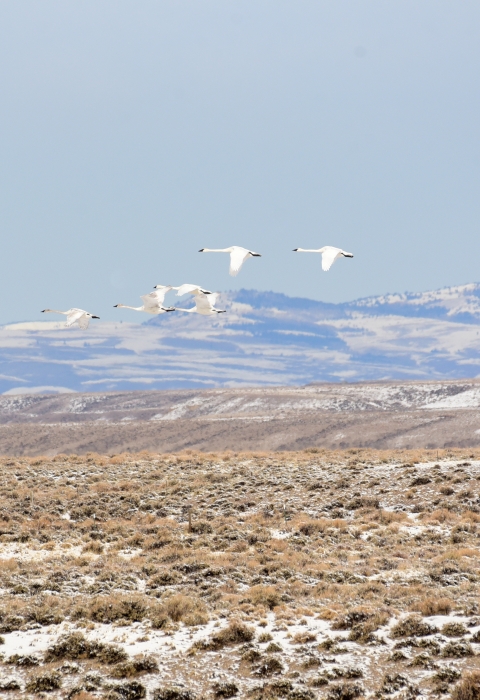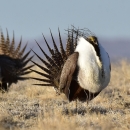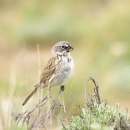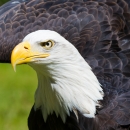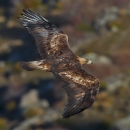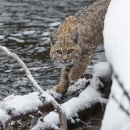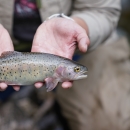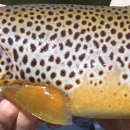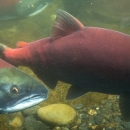Seasons of Wildlife
Spring and Migration
Spring begins as ice on the river begins to break up and melt. Winter’s grip has not gone, but we know spring is on its way when the first red-winged blackbird males return. This begins a continuous flow of different bird species into and through the refuge. Each day offers something new to be seen, especially at the visitor's center feeders. Birds are in their bright and colorful breeding plumage and the observant visitor can witness eons-old courtship rituals. Large flocks of mountain bluebirds against the background of a late spring snow is a memorable sight. Bald eagles begin laying and incubating eggs in early March and will remain on the nest through inclement weather. Some Canada geese, trumpeter swans, and mallards wintered here on open stretches of the river, new species of ducks begin to arrive in early March. Common goldeneyes and ring necked ducks arrive in numbers with aggressive courtship displays to watch. Canada geese and trumpeter swan pairs select and begin defending a nesting site from others of their kind. Next to arrive are widgeon, gadwalls, shovelers, as well as green winged, blue winged, and cinnamon teal. The last of the ducks to arrive are ruddy ducks with their electric blue bills and stiff erect tails. Shorebird migration lasts from early April through mid-May. One of the last migratory “shows” usually concludes little noticed. In May, secretive warblers move onto the Refuge to rest and feed on insects among the newly emerging leaves of narrow leaf cottonwood and other riparian riparian
Definition of riparian habitat or riparian areas.
Learn more about riparian vegetation. They have migrated here from some distance, a few as far as southern South America. One of the best places in Wyoming to find these warblers during spring migration is from Refuge Headquarters to the base of Fontenelle Dam.
Summer Breeding and Nesting
While some birds head further north to breed, over 113 species stay at Seedskadee National Wildlife Refuge through the summer to breed and raise their young. Young of the year birds can be seen as early as April when the bald eagle eaglets make their debut. Young of the year pronghorn fawns, mule deer and white-tailed deer fawns, and moose calves are born during May and into June. Trumpeter swan cygnets begin to hatch in mid June, but may not be readily observed for months as the adult swans hide them in heavy wetland vegetation. Later in June and July, visitors can view ducklings in the wetlands and a number of species of young sparrows, thrashers, and other songbirds throughout the Refuge as they learn to fly. Beginning in mid June and continuing through early September, sage grouse hens lead their young to the Refuge's wet meadows and riverine areas for water, insects, and the palatable green vegetation. Hummingbirds arrive to the refuge late, usually late June, and stay into the fall, they are often seen around the visitor's center with their long, needle-like beaks buried in a Rocky Mountain beeplant or showy milkweed bloom.
Fall and Migration
Trumpeter swan cygnets have grown through the summer and by September begin to make their first attempts to fly. Common nighthawk numbers begin to build along the river. At dusk in early September, the sky appears to be full of nighthawks and then one day they are all gone, further south on their migration out of Wyoming and the north. Kokanee salmon and brown trout move onto the Refuge to spawn. Large “redds” of kokanee salmon can be seen in October, actually seeming to turn the river red is places, as they have changed into their red spawning colors. Concentrations of bald eagles arrive to catch salmon for the fall feast. As wetlands at higher elevations begin to freeze for the winter, ducks, mergansers, geese, and trumpeter swans begin to arrive in larger concentrations. The rut or breeding season for pronghorn, mule deer, moose, and elk occurs during the fall, and large males of each species may be seen challenging each other for dominance.
Winter Residents and Visitors
A few otherwise uncommon species of migratory birds move onto the refuge for the winter. Large numbers of rough-legged hawks arrive from the arctic region and spend the winter hunting the wetland and riverine habitats. Gray-crowned rosy finches migrate from high elevations in the mountains of Wyoming to lower elevations for the winter. They can often be spotted around refuge headquarters near bird feeders or picking seeds from annual weeds. Trumpeter swan numbers may increase to more than 200 birds, as they move onto the refuge from areas which freeze during the height of winter. In most years, the Green River stays open from Highway 28 north to Fontenelle Dam, which allows some waterfowl to winter here as well. Winter is a hard time for the wildlife who remain here, with limited food supplies and often harsh weather. A few of the refuge roads are closed to vehicles during the winter to limit disturbance and stress to the wildlife during this critical time of year.
Featured Species
Seedskadee National Wildlife Refuge and the Green River corridor, above and below the refuge, is one of the primary migration corridors through southwest Wyoming. In an otherwise arid landscape, the presence of the Green River and associated riparian riparian
Definition of riparian habitat or riparian areas.
Learn more about riparian and wetland habitats provide critical habitat for migrating birds. Birds travel to and through the refuge to eat and rest during migration, with many staying to nest, breed and raise young. In addition to resident and migrating birds, large and small mammals, reptiles, amphibians, and even bats use the refuge year round or spend a portion of the year with us.
